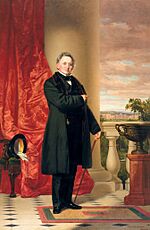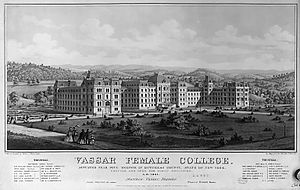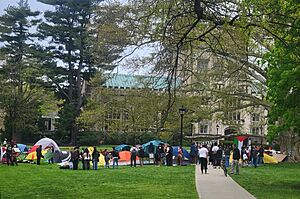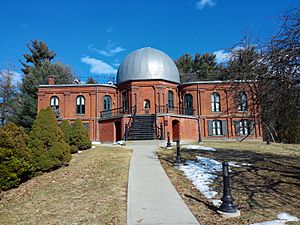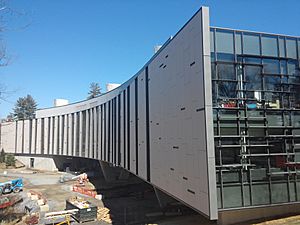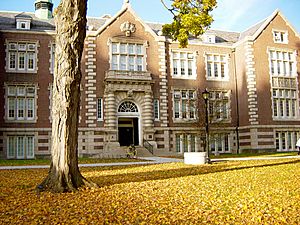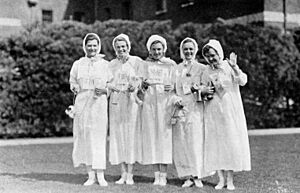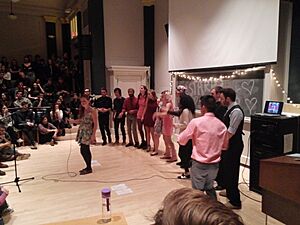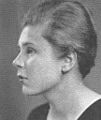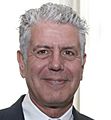Vassar College facts for kids
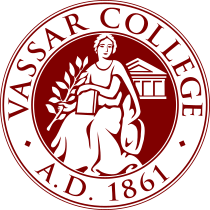 |
|
| Type | Private liberal arts college |
|---|---|
| Established | 1861 |
|
Academic affiliations
|
|
| Endowment | $1.301 billion (2024) |
| President | Elizabeth H. Bradley |
|
Academic staff
|
297 FT/ 61 PT (2023) |
| Undergraduates | 2,456 (2023) |
| Location |
,
U.S.
41°41′15″N 73°53′45″W / 41.68750°N 73.89583°W |
| Campus | Suburban, 1,000 acres (400 ha) |
| Newspaper | The Miscellany News |
| Colors | Burgundy and gray |
| Nickname | Brewers |
|
Sporting affiliations
|
NCAA Division III – Liberty League |
| Mascot | The Brewer |
Vassar College is a private liberal arts college in Poughkeepsie, New York. It was founded in 1861 by Matthew Vassar as a school for women. At the time, it was only the second college in the United States that gave degrees to women. In 1969, the college began accepting men and is now open to everyone.
Vassar offers degrees in more than 50 subjects. The college's sports teams are called the Brewers and play in the NCAA Division III Liberty League. As of 2023, about 2,450 students attend Vassar.
The college is one of the historic Seven Sisters, a group of top colleges that were originally just for women. The campus is very large, covering over 1,000 acres with more than 100 buildings. It is also an arboretum, which means it's a special place for growing many types of trees. The campus has over 200 kinds of trees and a large nature area.
Contents
History
Vassar was founded in 1861 as "Vassar Female College." Its founder, Matthew Vassar, was a brewer who wanted to create a top-level school for women. A year later, he removed the word "Female" from the name. The college officially began accepting men in 1969.
Vassar was the second of the Seven Sisters colleges. These schools were seen as partners to the all-male Ivy League colleges. The first scientist hired by Vassar was the famous astronomer Maria Mitchell in 1865.
Before Vassar started accepting men, it considered joining with Yale University. However, the college decided to remain independent and invite men to study at its own campus instead.
In its early days, many students at Vassar came from wealthy and influential families. Even future U.S. President Franklin Delano Roosevelt served as a trustee for the college.
Today, about 2,450 students go to Vassar, and most of them live on campus. The college has an 8-to-1 student-to-faculty ratio, which means classes are small, with an average of 17 students. This allows students to get more attention from their professors.
Vassar has a need-blind admissions policy. This means the college accepts students based on their achievements, not on how much money their family has.
Presidents of Vassar
Vassar has had many presidents throughout its history. Here is a list of them and when they served.
| Name | Dates |
|---|---|
| Milo P. Jewett | 1861–1864 |
| John H. Raymond | 1864–1878 |
| Samuel L. Caldwell | 1878–1885 |
| James Monroe Taylor | 1886–1914 |
| Henry Noble MacCracken | 1915–1946 |
| Sarah Gibson Blanding | 1946–1964 |
| Alan Simpson | 1964–1977 |
| Virginia B. Smith | 1977–1986 |
| Frances D. Fergusson | 1986–2006 |
| Catharine Bond Hill | 2006–2016 |
| Elizabeth H. Bradley | 2017–present |
Campus
Vassar's campus is a beautiful, 1,000-acre space with over 100 buildings. The buildings show off many different architectural styles, from classic Gothic to modern designs.
Famous Buildings
The Main Building is a key landmark on campus. When it opened in 1865, it was one of the largest buildings in the country. It was designed by architect James Renwick Jr. and used to hold the entire college, including classrooms, dorms, and a library. Both the Main Building and the original Vassar College Observatory are National Historic Landmarks.
Another interesting building is Noyes House, a dormitory designed by Eero Saarinen in 1958. It has a unique, futuristic look and is often used for concerts and readings.
Libraries
Vassar has eight libraries with about 1 million books and thousands of magazines and newspapers. It has one of the largest library collections of any undergraduate college in the United States. The libraries also have special collections with items from famous people like Albert Einstein and Elizabeth Bishop.
The main library is the Thompson Memorial Library. Another library, the Van Ingen Art Library, was renovated to restore its original 1937 appearance.
Art and Science Centers
The Frances Lehman Loeb Art Center is the college's art museum. It features a wide range of art, including a gallery for photography.
In 2011, Vassar began a major project to improve its science buildings. This included building the Bridge for Laboratory Sciences, a modern facility that connects to other science buildings on campus.
Student Housing
Most students live on campus in one of the nine residence halls, or dorms. Some of the dorms, like Strong House and Jewett House, were built over 100 years ago and have classic architectural styles. Others, like Noyes House, are more modern.
Older students often live in on-campus apartments. Vassar guarantees housing for all of its full-time students, so everyone has a place to live.
What You Can Study
Vassar is a liberal arts college, which means students study a wide variety of subjects. Students can choose from over 50 majors.
Based on graduates from 2021, the most popular majors were:
- Biology
- Economics
- Political Science and Government
- English
- Biochemistry
- Neuroscience
- Computer Science
Getting into Vassar
Vassar is a very selective college. For the class that started in the fall of 2023, the college received over 12,000 applications and accepted about 18% of them. Students who are accepted usually have very high grades and test scores. For example, 79% of new students were in the top 10% of their high school class.
College Rankings
Vassar is often ranked as one of the top liberal arts colleges in the country. In 2025, U.S. News & World Report ranked Vassar as the 12th best liberal arts college in the United States. It has also been praised for its financial aid, value, and support for students from different backgrounds.
Student Life
Life at Vassar is full of fun traditions and activities outside of class.
Traditions
One of the biggest events of the year is Founder's Day. It started as a surprise birthday party for the college's founder, Matthew Vassar. Today, it's a huge festival with music, games, and a different theme each year. Past themes have included Alice in Wonderland, Dinosaurs, and Nintendo.
Clubs and Groups
Vassar has many student-run clubs and organizations.
- Music: There are nine a cappella groups, which are singing groups that don't use instruments. The Night Owls are one of the oldest college a cappella groups in the country. Other groups sing everything from show tunes to Disney songs.
- Theater: The oldest theater group on campus is the Philaletheis Society, founded in 1865. There are many other groups for different types of theater, including experimental plays, musicals, and Shakespeare.
- Comedy: The college has several sketch comedy and improv groups that put on shows for students.
- Newspaper: The Miscellany News is the student newspaper. It has been published every week since 1866, making it one of the oldest college newspapers in the U.S.
Sports
Vassar's sports teams are called the Brewers. The name comes from founder Matthew Vassar, whose family owned a successful brewery. The teams compete in Division III of the NCAA.
The college has teams for many sports, including volleyball, cycling, and rugby. In 2018, the women's rugby team won a national championship, which was a first for the school.
Famous People from Vassar
Many famous and successful people have graduated from Vassar College.
-
Elizabeth Bishop, Pulitzer Prize-winning poet
-
Anthony Bourdain, author and TV host
-
Jane Fonda, Academy Award-winning actress
-
Anne Hathaway, Academy Award-winning actress
-
Grace Hopper, a pioneer in computer programming
-
Lisa Kudrow, Emmy Award-winning actress
-
Edna St. Vincent Millay, Pulitzer Prize-winning poet
-
Mark Ronson, Grammy Award-winning musician
-
Meryl Streep, Academy Award-winning actress
-
Anita Florence Hemmings, first known graduate of Vassar with African ancestry
Some notable alumni include:
- Meryl Streep (1971), a three-time Academy Award-winning actress.
- Lisa Kudrow (1985), an Emmy Award-winning actress known for playing Phoebe on Friends.
- Grace Hopper (1928), a computer scientist who helped invent early programming languages.
- Elizabeth Bishop (1934), a Pulitzer Prize-winning poet.
- Edna St. Vincent Millay (1917), another Pulitzer Prize-winning poet.
- Jacqueline Kennedy Onassis, former First Lady of the United States (attended but did not graduate).
- Anne Hathaway, an Academy Award-winning actress (attended but did not graduate).
- Mark Ronson, an Academy Award-winning musician and producer (attended but did not graduate).
- Anthony Bourdain, a famous chef and television host (attended but did not graduate).
See also
 In Spanish: Vassar College para niños
In Spanish: Vassar College para niños


